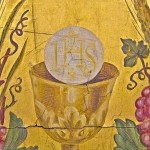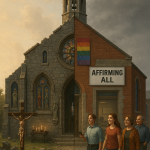
Was Jesus married?
Shocking news pieces attempting to debunk the orthodox version of the life of Jesus are an annual festival, but The Atlantic’s piece “The Unbelievable Tale of Jesus’s Wife” turns the tables on the demythologizers. It is no doubt the most riveting piece of investigative reporting I’ve read in the recent past. The Atlantic’s blurb doesn’t do justice to the essay’s psychological depth, it’s spellbinding tale of confirmation bias:
Where did that papyrus that mentions Jesus’s wife come from? And is it a credible source? We investigate in our latest issue.
Oh, there’s more, so much more! Here’s how it starts:
On a humid afternoon this past November, I pulled off Interstate 75 into a stretch of Florida pine forest tangled with runaway vines. My GPS was homing in on the house of a man I thought might hold the master key to one of the strangest scholarly mysteries in recent decades: a 1,300-year-old scrap of papyrus that bore the phrase “Jesus said to them, My wife.” The fragment, written in the ancient language of Coptic, had set off shock waves when an eminent Harvard historian of early Christianity, Karen L. King, presented it in September 2012 at a conference in Rome.
Never before had an ancient manuscript alluded to Jesus’s being married. The papyrus’s lines were incomplete, but they seemed to describe a dialogue between Jesus and the apostles over whether his “wife”—possibly Mary Magdalene—was “worthy” of discipleship. Its main point, King argued, was that “women who are wives and mothers can be Jesus’s disciples.” She thought the passage likely figured into ancient debates over whether “marriage or celibacy [was] the ideal mode of Christian life” and, ultimately, whether a person could be both sexual and holy . . .
The Catholic Church puts an enormous amount of emphasis upon marriage. Isn’t this odd for a tradition that was founded upon the teachings of a celibate Messiah? What could celibates know about marriage and sexuality?
Most Catholics have probably heard a millions versions of these questions from people with smug looks on their faces. It is the sort of look that says “I’ve caught the simpletons in a massive contradiction. Let’s watch them squirm.”
My preliminary surveys indicate some, not all, Catholics might be surprised that the perfectly orthodox (small “O”) answer to this question is that there’s nothing odd about the Catholic obsession with marriage, because Jesus is married as well. No, I’m not talking about Swedenborg’s The Delights Of Wisdom Pertaining To Conjugial Love where people get married in heaven. This is different and decidedly not heterodox.
 If anything, the emphasis upon the fundamental importance married state and the nuptial metaphor has increased in Catholic theology over the past 100 years. Prominent 20th century theologians almost unanimously picked up on this favorite medieval, patristic, and biblical theme in opposition to the poetic dryness of early modern Neo-Scholasticism. Fergus Kerr charts this epochal shift in his Twentieth-Century Catholic Theologians. Its subtitle, From Neoscholasticism to Nuptial Mysticism, highlights it.
If anything, the emphasis upon the fundamental importance married state and the nuptial metaphor has increased in Catholic theology over the past 100 years. Prominent 20th century theologians almost unanimously picked up on this favorite medieval, patristic, and biblical theme in opposition to the poetic dryness of early modern Neo-Scholasticism. Fergus Kerr charts this epochal shift in his Twentieth-Century Catholic Theologians. Its subtitle, From Neoscholasticism to Nuptial Mysticism, highlights it.
I should stop teasing you the reader and get to the heart of the matter. Addison Hodges Hart’s little study, The Woman, the Hour, and the Garden: A Study of Imagery in the Gospel of John, quickly resolves the apparent contradiction of the heavy emphasis upon marriage in a religion founded by a celibate Messiah. He does so on the book’s first page:
This short book was born partly out of a reaction to the canard that Jesus was married to Mary Magdalene. It is an assertion we have heard repeated in recent decades, and at the time of this writing it is yet again in the news, and doubtless it will crop up again. I have no interest in addressing the topic directly, however. I bring it up only to confess what moved me to write this brief study in the first place, and to say that the idea that Jesus was (or, rather, is ) “wed” is a metaphor as old as Christianity itself. Where the sensationalists who claim that Jesus was a married man make their primary mistake is to misread early Christian metaphors as being historically suggestive of some long- buried facts, usually purported to be long buried by a conniving, conspiratorial church hierarchy. What it shows is that literalism is not merely a fault of believers; it can also be detected among those who regard belief as naïve. The latter can be as deaf and blind to metaphor and symbol as any literalist believer.
As we have seen with Jeremiah, marriage is a metaphor as old, if not older than Israel. Jeremiah’s extension of it is very problematic, but that doesn’t change the metaphor’s centrality.
 The fact that unbelievers frequently misread this crucial metaphor is not surprising. What’s surprising is how few believers are aware of their own heritage and how it permits them to turn the tables on their critics. The state of things is such, The Woman, the Hour, and the Garden suggests, because of the way the Church is organized much differently today than it was in Early Christianity:
The fact that unbelievers frequently misread this crucial metaphor is not surprising. What’s surprising is how few believers are aware of their own heritage and how it permits them to turn the tables on their critics. The state of things is such, The Woman, the Hour, and the Garden suggests, because of the way the Church is organized much differently today than it was in Early Christianity:
We should assume that John’s church was, in fact, a community of mystical participation, not merely a “church” as we usually think of it today — no pews, vestments, administrative headquarters, and so on. A community of disciples, united under the spiritual oversight of wise elders (think rabbis, or even “gurus”), with a liturgy rich in mystical symbolism, would not have been unusual for a religious association in that age. Mystical practices were likely part of his church’s life. (Both contemporary Jewish and Greek mysticism influenced early Christianity.) The language of “rebirth” and “eternal life” would have meant more than simple doctrinal assent. It was something that the community experienced in their shared life, and that life would have been rigorous in its moral guidelines, commitment, and forms of worship. A “loose” community in matters of faith and practice could not have endured for long.
The Woman, the Hour, and the Garden: A Study of Imagery in the Gospel of John is the next best thing to instruction by such an elder. Hart is a sure guide who takes you through the thickets of the New Testament’s use of bridal, garden, and temporal metaphors. The book reads a bit like a great crime or mystery novel.
When the context is totally fleshed out the scales fall from your eyes. You are then emboldened to go back into the New Testament with new eyes and make sense of previously confusing episodes–including the ones that feature Mary Magdalene as their chief protagonist. It’s also just damn good reading.
I couldn’t recommend The Woman, the Hour, and the Garden more enthusiastically, especially to those who have read The Atlantic piece. Familiarize yourself with the orthodox believer’s tale of Jesus’s wife, because you are part of it.
https://www.youtube.com/watch?v=9VCX-pcDz-o
By the way, did you know that Jesus Didn’t Call God Daddy, or that Difference, Disharmony, and Drama Are the Essence of Marriage? Or, did you ever wonder . . Does Catholic Monasticism Have a Sexual Orientation?
Please consider making a donation to this blog through the donation button on the upper right side of its homepage.
Stay in touch! Like Cosmos the in Lost on Facebook:












